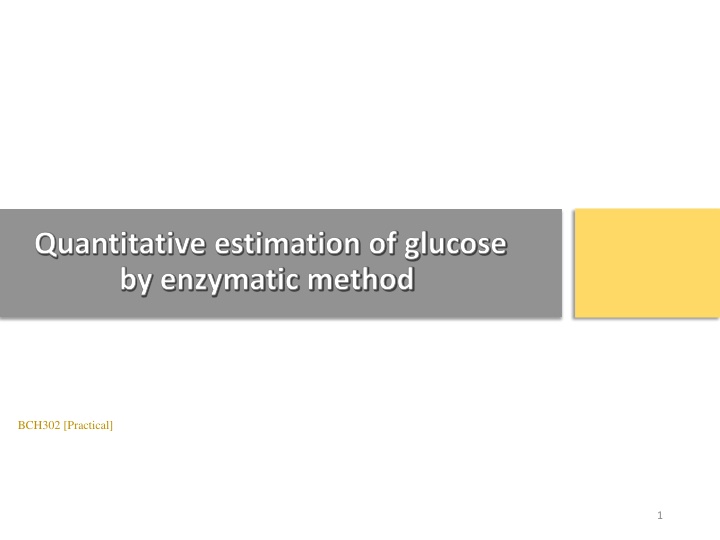Quantitative Estimation of Glucose by Enzymatic Method in Blood Samples
Estimation of blood glucose levels is crucial for diagnosing and managing conditions like diabetes mellitus. This practical involves using the enzymatic method with glucose oxidase to quantitatively determine glucose levels in serum. The enzymatic reaction converts glucose to gluconic acid and hydrogen peroxide, leading to the formation of a stable red dye that is proportional to the glucose content. Follow the steps outlined to accurately measure blood glucose levels.
Download Presentation

Please find below an Image/Link to download the presentation.
The content on the website is provided AS IS for your information and personal use only. It may not be sold, licensed, or shared on other websites without obtaining consent from the author.If you encounter any issues during the download, it is possible that the publisher has removed the file from their server.
You are allowed to download the files provided on this website for personal or commercial use, subject to the condition that they are used lawfully. All files are the property of their respective owners.
The content on the website is provided AS IS for your information and personal use only. It may not be sold, licensed, or shared on other websites without obtaining consent from the author.
E N D
Presentation Transcript
Quantitative estimation of glucose by enzymatic method BCH302 [Practical] 1
Methods of estimation the reducing sugar content in solution : There are three main methods of estimation the reducing sugar content in solution : 1. Reduction of cupric to cuprous salts. 2. Reduction of ferricyanide to ferrocyanide. 3. Enzymatic method. Note: Enzymatic method is the most commonly used in clinical laboratories for glucose estimation . 2
Methods of estimation the reducing sugar: 1- Reduction of cupric to cuprous salts: Reducing sugars contains an aldehyde or keto groups reduced alkaline copper to Cuprous oxide. Cuprous oxide is allowed to react with phosphomolybdate solution which is reduced and forms blue color. The intensity of color is measured on colorimeter against standard. 2- Reduction of ferricyanide to ferrocyanide: Reduction of ferricyanide to ferrocyanide by reducing sugars in alkaline solution . In presence of zinc ions , the ferrocyanide formed is precipitated as a zinc complex. 3- Enzymatic method: Glucose is commonly measured using an enzyme to convert the glucose to a product that can be easily detected. Common enzymes used are glucose oxidase, glucose dehydrogenase and hexokinase. 3
Determination of blood glucose: Glucose is a major carbohydrates present in the peripheral blood. The oxidation of glucose is the major source of cellular energy in the body. Glucose determination are run primarily to aid in the diagnosis and treatment of diabetes-mellitus. Range of expected values in serum (Normal range): 70-105 mg/dl (3.9-5.8 mmol/L) - Fasting 4
Experiment 1 : Estimation of blood glucose level by Glucose oxidase Objective: Quantitative determination of glucose in serum using a modified glucose oxidase (GOD) / Trinder method. Principle: The enzymatic reaction sequence employed in the assay of glucose is as follows: 1- Glucose oxidase converts glucose, in the presence of oxygen, to gluconic acid and hydrogen peroxide: GOD Glucose + O2 + H2O Gluconic acid + H2O2 2- The hydrogen peroxide is oxidatively coupled with 4-aminoantipyrine and p-hydroxybenzene sulfate (PHBS) in the presence of peroxidase to form a stable red quinoneimine dye: Peroxidase (POD) 2H2O2 + 4-Aminoantipyrine + PHBS Quinoneimine dye + 4 H2O The quinoneimine dye has an absorption maximum at 510nm. The amount of colour produced is directly proportional to the glucose content of the sample. 6
Experiment 1 : Estimation of blood glucose level by Glucose oxidase Method: 1. Pipette to clean 3 cuvettes: Blank Standard 1 ml (1000 l) Test Glucose oxidase liquid reagent 1 ml (1000 l) 1 ml (1000 l) Pre-warm at 37 C and add: - - Glucose standard Sample 0.01 ml (10 l) - - 0.01 ml (10 l) 2. Mix and incubate at 37 C for 15 min. 3. Read the absorbance of sample and standard at 510nm against blank. 7
Experiment 1 : Estimation of blood glucose level by Glucose oxidase Results: Use the absorbance measurement of the STANDARD and TEST to calculate glucose values as follows: Example: A (standard) = 0.325 A(test) = 0.300 So: 0.300 0.325 X 100 mg/dl = 92 mg/dl Normal 8























